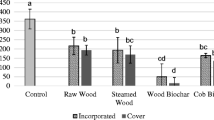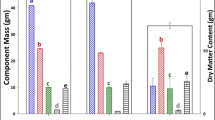Abstract
Corn stover has great potential as a biomass feedstock due its widespread availability. However, storage characteristics of moist corn stover harvested from single-pass harvesters have not been well quantified. In 2007, whole-plant corn stover at 19.1–40.3% (w.b.) moisture content was stored for 237 days in aerobic piles, one covered and one uncovered, as well an anaerobic silo bag. In 2008, two stover materials—whole plant and cob/husk from 31.7% to 58.1% (w.b.) moisture—were stored for 183 or 204 days in covered and uncovered anaerobic piles, ventilated bags, or anaerobic silo bags. Stover stored in uncovered piles was rehydrated by precipitation, which increased biological activity resulting in dry matter (DM) losses from 8.2% to 39.1% with an average of 21.5%. Stover in covered piles was successfully conserved when the average moisture was less than 25% (w.b.) with DM losses of 3.3%. Stover above 36% (w.b.) moisture and piled under a plastic cover had DM losses from 6.4% to 20.2% with an average of 11.9%. Localized heating occurred in the aerobic piles when moisture was above 45% (w.b.) which lead to temperatures where spontaneous combustion might be a concern (i.e., >70°C). Ambient air blown through a center tube in the ventilated storage bag dried stover near the tube to an average of 24.2% (w.b.), but the remainder of the bag averaged 46.8% (w.b.) at removal. Loss of DM ranged from 7.4% to 22.0% with an average of 11.8% with this storage method. Stover was most successfully conserved in the bags where anaerobic conditions were maintained. Under anaerobic conditions, DM losses ranged from 0.2% to 0.9%. When anaerobic conditions were not maintained in the silo bag, DM losses averaged 6.1% of DM. Anaerobic storage is the best solution for conserving the value of moist corn stover.






Similar content being viewed by others
References
ASABE (2008) Standard S358.2: moisture measurement—forages. ASABE, St. Joseph
ASABE (2008) Standard S424.1: method of determining and expressing particle size of chopped forage materials by screening. ASABE, St. Joseph
Ayers GE, Buchele WF (1971) Harvesting and storing corn plant forage. ASAE Paper No. 71-665. ASABE, St. Joseph, MI
Dewar WA, McDonald P, Whittenbury R (1963) The hydrolysis of grass hemicelluloses during ensilage. J Sci Food Agric 14:411
Garvin RV, Inman LR, Schuette AP (1995) Method for treatment of bagged organic materials. United States Patent No. 5,461,843
Hoglund CR (1964) Comparative storage losses and feeding values of alfalfa and corn silage crops when harvested at different moisture levels and stored in gas-tight and conventional tower silos. An appraisal of research results. Mich. State Univ., Dept. Agr. Econ. Mimeograph 946
Kadam KL, McMillan JD (2003) Availability of corn stover as a sustainable feedstock for bioethanol production. Bioresour Technol 88:17–25
Lorenz AJ, Coors JG, de Leon N, Wolfrum EJ, Hames BR, Sluiter AD, Weimer PJ (2009) Characterization, genetic variation, and combining ability of maize traits relevant to the production of cellulosic ethanol. Crop Sci 49(1):85–98
McDonald P, Henderson AR, Heron SJE (1991) The biochemistry of silage. Cambrian Printers Ltd, Aberystwyth
Melvin JF (1965) Variations in the carbohydrate content of lucerne and the effect on ensilage. Aust J Agric Res 16:951
Miller DA, Rotz CA (1995) Forages volume 1: an introduction to grassland agriculture. Chapter 13, harvesting and storage. Iowa State University Press, Ames
Muck RE (1988) Factors influencing silage quality and their implications for management. J Dairy Sci 71:2992–3002
Pitt RE (1990) Silage and hay production. Northeast Regional Agricultural Engineering Service Publication Service Number 5. Cornell University, Ithaca
Pitt RE, Muck RE (1993) A diffusion model of aerobic deterioration at the exposed face of bunker silos. J Agric Eng Res 55(1):11–26
Rotz CA, Muck RE (1994) Changes in forage quality during harvest and storage. In: Forage quality, evaluation and utilization. Madison, Wis.: American Society of Agronomy, Crop Science Society of America, and Soil Science Society of America, 828–68
SAS Institute (2008) SAS proprietary software, version 9.2. SAS Institute, Cary
Shinners KJ, Binversie BN (2007) Fractional yield and moisture of corn stover biomass produced in the northern US Corn Belt. Biomass Bioenergy 31(8):576–584
Shinners KJ, Binversie BN, Muck RE, Weimer PJ (2007) Comparison of wet and dry corn stover harvest and storage. Biomass Bioenergy 31(4):211–221
Shinners KJ, Adsit GS, Binversie BN, Digman MF, Muck RE, Weimer PJ (2007) Single-pass, split-stream of corn grain and stover. Trans ASABE 50(2):355–363
Shinners KJ, Hoffman DS, Boettcher GC, Munk JT, Muck RE, Weimer PJ (2009) Single-pass harvest of corn grain and stover: performance of three harvester configurations. Trans ASABE 52(1):51–60
Shinners KJ, Bennett RG, Hoffman DS (2009b) Single- and two-pass corn stover harvesting systems. ASABE Paper No. 095652. ASABE, St. Joseph, MI
USDA (2009) USDA feed grain baseline, 2009–18. U.S. Department of Agriculture, Washington, Available at: http://www.ers.usda.gov/Briefing/Corn/2009baseline.htm. Accessed August, 2009
USDOE (2008) Theoretical ethanol yield calculator. U.S. Department of Energy, Washington, Available at: http://www.eere.energy.gov/biomass/ethanol_yield_calculator.html. Accessed August, 2009
Whitlock LA, Wistuba T, Siefers MK, Pope RV, Brent BE, Bolsen KK (2000) Effect of level of surface-spoiled silage on the nutritive value of corn silage-based rations. Kansas Agric Exp Sta Rpt Prog 850:22–24
Acknowledgments
This research was partially sponsored by the University of Wisconsin College of Agriculture and Life Sciences, John Deere Harvester Works, John Deere Moline Technology and Innovation Center, and the DOE (Grant No. NRCS 68-3A75-4-137). This research could not have been completed without the assistance of the staff of the Arlington Agricultural Research Station.
Author information
Authors and Affiliations
Corresponding author
Rights and permissions
About this article
Cite this article
Shinners, K.J., Wepner, A.D., Muck, R.E. et al. Aerobic and Anaerobic Storage of Single-pass, Chopped Corn Stover. Bioenerg. Res. 4, 61–75 (2011). https://doi.org/10.1007/s12155-010-9101-7
Published:
Issue Date:
DOI: https://doi.org/10.1007/s12155-010-9101-7




